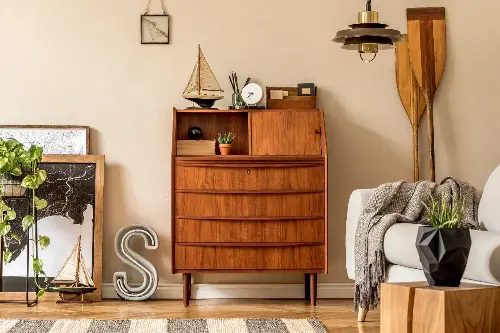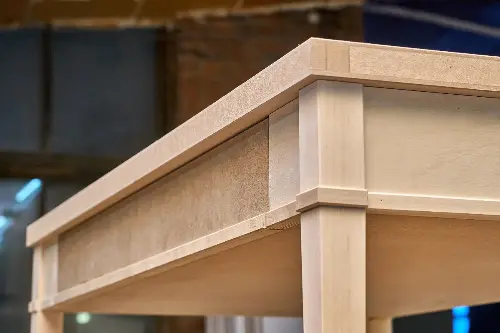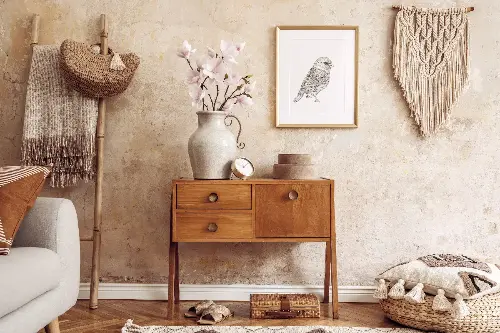The conundrum of choosing between the timeless allure of wooden furniture and the modern sheen of Medium Density Fibreboard (MDF) is a common dilemma in the realm of interior design. Each material brings its unique characteristics to the table, so to speak, contributing to the ambience and functionality of your living space. Whether refurbishing a quaint cottage or outfitting a sleek, contemporary apartment, the decision ultimately hinges on an array of factors, from aesthetic preference to practicality and sustainability.

The Ageless Charm of Wood
There's something inherently warm and inviting about wooden furniture. Its solid presence and natural grain patterns evoke a sense of organic beauty that's hard to replicate. Solid wood pieces often become heirlooms, passed down through generations, telling their own tales of bygone times. The craftsmanship that goes into creating a piece of solid wood furniture can't be overstated; it's an art form that has been perfected over centuries.
Durability is another compelling reason to choose wooden furniture. With proper care, including regular cleaning and occasional waxing or oiling, wood can maintain its lustre and strength for decades. It can also be sanded down and refinished, offering a chance to revive an old piece or even change its appearance completely to match evolving decor trends.
Yet, wood isn't without its drawbacks. Solid wood can be heavy, making it challenging to move, and is not immune to the whims of environmental changes. It may expand or contract with varying humidity levels or temperatures, which can lead to warping or splitting over time. Additionally, high-quality wooden furniture often comes with a heftier price tag, reflecting both the quality of the material and the craftsmanship required.

The Progressive Allure of MDF
In the other corner of our design ring, MDF stands proud as a modern contender in the furniture industry. A composite material made by breaking down hardwood or softwood residuals into fine particles, MDF is then combined with wax and resin binder and formed into panels by applying high temperature and pressure. This process gives MDF its smooth texture and uniformity, making it a dream for manufacturers to work with, as it lacks the knots and grain variations found in natural wood.
The uniformity of MDF not only allows for a smooth finish but also means it can be precisely cut and moulded into an array of intricate and elaborate designs. This is particularly ideal for contemporary pieces that embrace clean lines and multiple storage options, such as TV units or modular shelving.
Moreover, when it comes to cost, MDF often proves to be the more economical choice. It's lighter than solid wood, which can make for easier transportation and rearrangement, and unlike solid wood, MDF doesn’t warp or crack due to changes in humidity.
However, it's crucial to address concerns about MDF's longevity and environmental impact. While it might not match the lifespan of solid wood, high-quality MDF can still serve well for many years if treated with care. It is also pivotal to ensure that the MDF you're purchasing adheres to strict formaldehyde emission standards, like those set by the European E1 standard, to minimise any health risks associated with its composite nature.

Sustainability Considerations
The environmental impact of one's furniture choices has become an increasingly important factor. Solid wood is often seen as the more sustainable choice, particularly if sourced from responsibly managed forests. However, the manufacturing processes involved in creating wooden furniture can be energy-intensive. MDF can be made from waste wood products, which might otherwise end up in a landfill, but concerns about the chemicals used in its production and the difficulty of recycling MDF furniture at the end of its life cannot be overlooked. It's about finding a balance between ecological responsibility and aesthetic desires.
The Verdict
Determining whether to invest in wooden furniture or to embrace the benefits of MDF involves weighing both the tangible and intangible benefits of each material. Your choice may be guided by practical considerations, such as budget, durability, and upkeep, or by a more emotional connection to the look and feel of the material in your home.
In conclusion, the debate between the classic appeal of wooden furniture and the contemporary edge of MDF is one that will continue to evolve as innovations and sustainability practices develop in the furniture industry. What remains constant is the need for careful consideration in choosing furnishings that not only fit one's personal style but will also stand the test of time, both in durability and design. Whether it is the warm, natural aesthetic of wood or the sleek, modern finish of MDF that catches your eye, each will create a distinct and cherished atmosphere in your sanctuary. Choose not just with your wallet but with your heart and mind as well.
